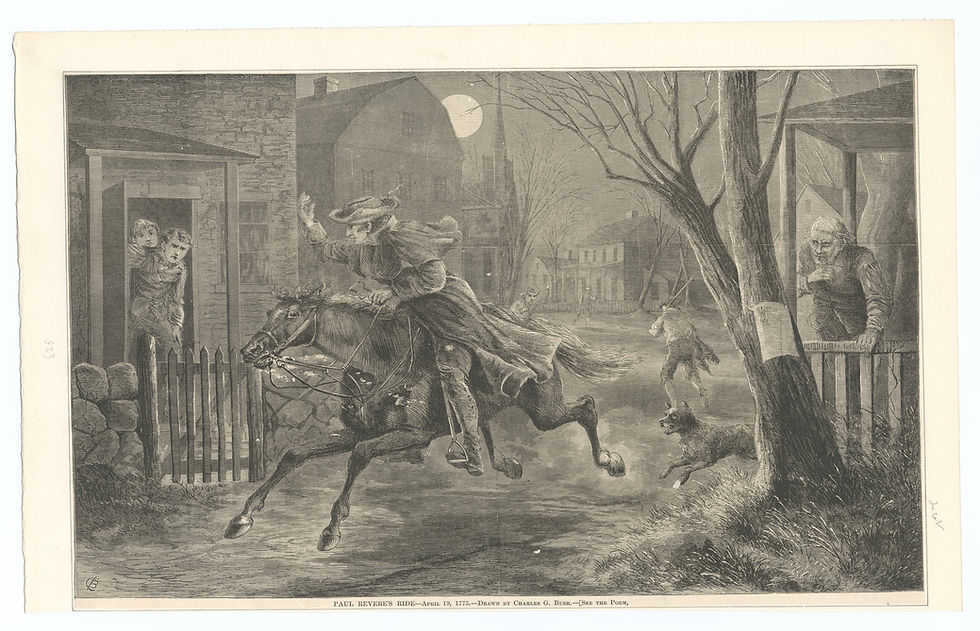This Day in History: William Dawes and his forgotten Midnight Ride
- tara
- Apr 6, 2021
- 3 min read
Updated: Apr 17, 2024
On this day in 1745, William Dawes is born. Oddly, his most famous deed is also the one for which he is most often forgotten. On April 18, 1775, he made a daring midnight ride at the same time as Paul Revere.
Did you know that more than one rider carried a warning that evening? Revere’s famous ride began when Dr. Joseph Warren sent for him around 10 pm. He wanted Revere to go to Lexington to warn Samuel Adams and John Hancock that British soldiers were coming, apparently with the intent to arrest them. But Warren had already sent one other man to Lexington with the exact same message. That man was Dawes.

Dawes took one route across Boston Neck. Revere took a different route across the Charles River. The logic was that, if the same message traveled by two different routes, then surely at least one of the messengers would arrive safely.
In other words, either Revere or Dawes could be caught. In fact, maybe it was almost expected that one of the men would get caught? What a risk they took, agreeing to be messengers that evening! Remember that capture could easily result in a punishment of death for an act deemed treasonous.
As it turns out, both men arrived at their destination safely. Dawes’s route was longer and included an especially risky pass through a gate closely guarded by British sentries. There are a few theories on how he got through the gate: Perhaps he was just well-disguised. One person remembered him “mounted on a slow-jogging horse, with saddle-bags behind him, and a large flapped hat upon his head to resemble a countryman on a journey.” Others speculate that Dawes knew one of the guards and got through that way. Or perhaps he managed to follow another group through the gate. Either way, the gate was reportedly closed not too long after he got through. He barely made it.
Dawes arrived in Lexington about half an hour after Revere. At that juncture, it was determined that they should continue on to Concord to help secure the weapons and supplies there. This time, they went together. As they traveled, they met and were accompanied by a new rider: Dr. Samuel Prescott.
Unfortunately, the Patriot party ran into British officers. Revere was briefly captured. Dawes got away from the British officers, but his horse took fright and ran off. Dawes ended up walking back to Lexington. In the meantime, Prescott got away and continued to Concord to deliver the warning.
Dawes’s role in that evening became lost over time. Historians offer a few possible reasons: First, he did not leave a detailed personal account of his ride, as Revere did. Second, he was a trusted member of the Sons of Liberty, but not as active as Revere. Third? Well, Henry Wadsworth Longfellow didn’t write a poem about him!
Another, less well-known poem was written about Dawes later, in 1896. It bemoans those who have forgotten Dawes:
“‘Tis all very well for the children to hear Of the midnight ride of Paul Revere; But why should my name be quite forgot, Who rode as boldly and well, God wot? Why should I ask? The reason is clear — My name was Dawes and his Revere.”
Sadly, perhaps I am adding insult to injury by posting a picture of REVERE’S ride?! Unfortunately, part of being a “forgotten” hero is that few artists ever memorialize your feat.
Primary Sources:
David Hackett Fischer, Paul Revere's Ride (1994)
February 25, 1799: William Dawes Dies (MassMoments, a project of MassHumanities)
Henry Ware Holland, William Dawes and His Ride with Paul Revere: An Essay Read Before the New England Historical Genealogical Society on June 7, A. D. 1876 (published 1878)
J.L. Bell, Did William Dawes Do More than Paul Revere? (Boston 1775 blog, Oct. 5, 2006)
The School Room: "What's in a Name?" (Wisconsin Journal of Education; Dec. 1897)






Комментарии